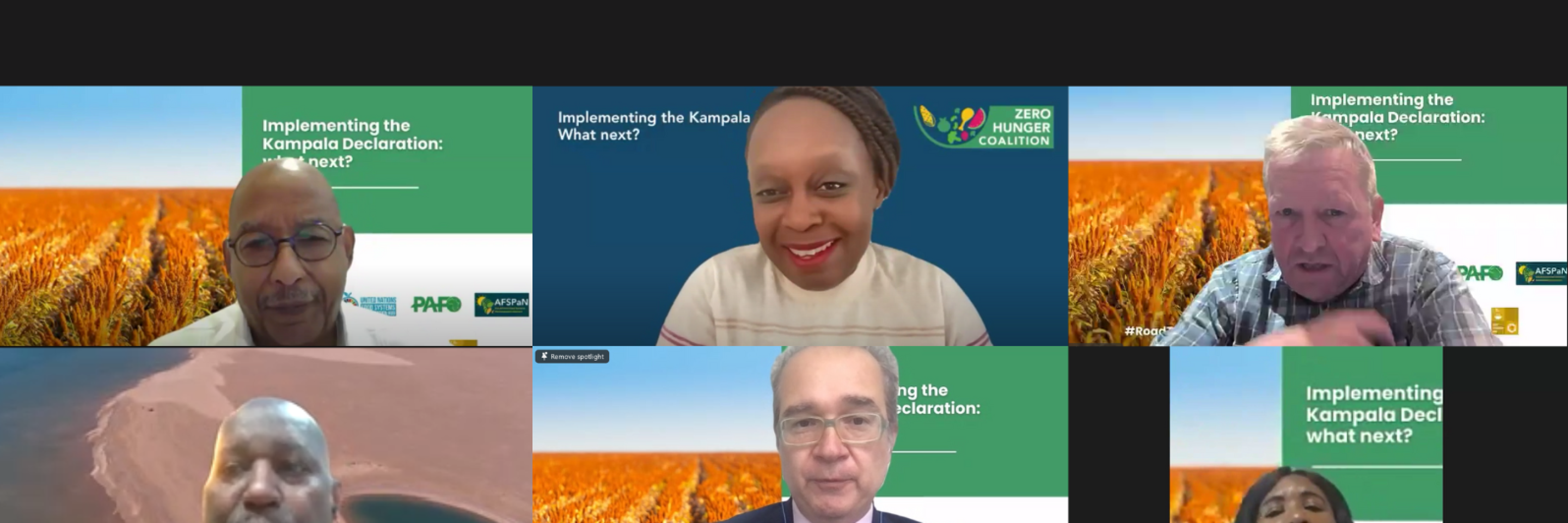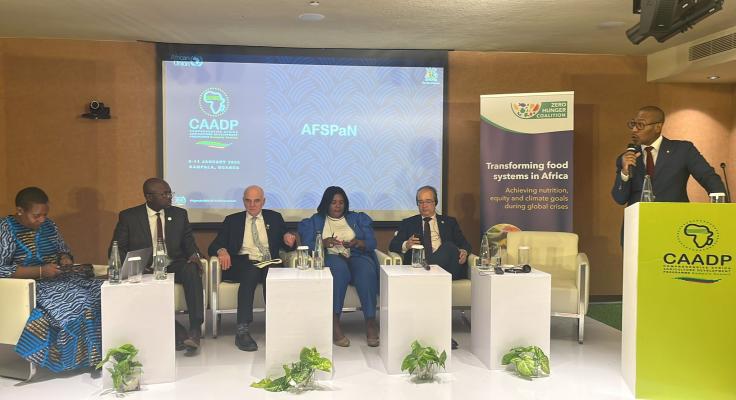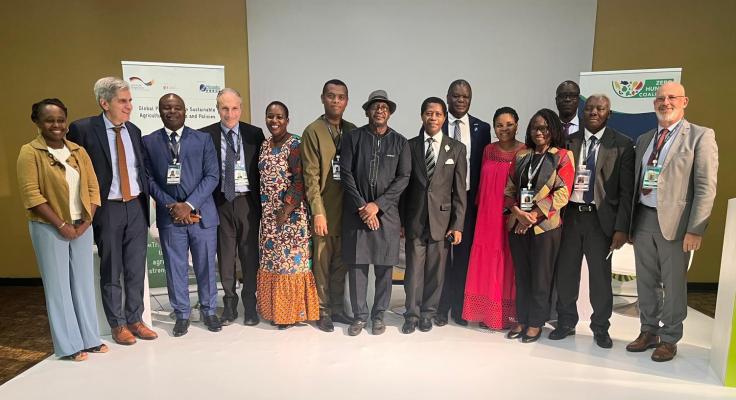
Implementing the Kampala Declaration: next steps
The new Comprehensive Africa Agriculture Development Programme (CAADP) Strategy and Action Plan 2026-2035, endorsed by 55 African Union member states earlier this year in Kampala, marks an important step for the continent’s agrifood systems transformation.
A recent webinar organised by the Zero Hunger Coalition brought together a panel of experts to discuss how to implement the new strategy and deliver concrete results. Moderated by Francine Picard, Coordinator of the Zero Hunger Coalition and Co-founder of the Shamba Centre for Food & Climate, the webinar detailed the ambitions of the new CAADP Strategy and Action Plan, the challenges that countries have faced in implementing earlier iterations of CAADP and how national and international partners can work together to achieve better results.
As Ms Picard noted in her introduction, the African continent faces significant challenges including climate change and rapid population growth, making economic transformation an imperative. “This Strategy and Action Plan is not a response to previous challenges but rather a bold reimagining of Africa's future in the face of a complex global landscape. This landscape is marked by a changing political reality towards international aid, with a shift towards more conditional, short-term assistance, and less investment in long-term developmental strategies,” she highlighted.
As a result, this shift introduces profound uncertainties for the future of development, placing the principles of multilateralism at risk and signaling the beginning of a post-ODA era.
Understanding the Kampala Declaration
The targets defined in the CAADP Strategy and Action Plan are ambitious. As detailed by Dr Hamady Diop, Special Advisor on Food Systems for the African Union Commission, the six strategic objectives encompass the following:
Intensify sustainable food production, trade and agro-industrialisation
Boost investment and finance
Food security and nutrition
Advance inclusivity and equitable livelihoods
Build resilience of agrifood systems
Strengthen food system governance
For Dr Diop, the development of the third CAADP framework benefited from an inclusive approach that encouraged the participation of a variety of institutions as well as women, youth and the private sector in a series of regional dialogues. As he noted, “every single voice was heard in a process that was also flexible, allowing us to learn and adjust as we moved together and shared knowledge.”
Compared with the previous CAADP frameworks, guided by the Maputo Declaration (2003) and Malabo Declaration (2014), the new CAADP Strategy and Action Plan adopts the concept of agrifood systems with transformation from production to fork. It brings together nutrition, economic growth, equity and climate resilience.
As a next step, regional dialogues will commence to review the CAADP indicators and ensure their alignment with the new strategy. Full implementation is expected to begin in 2026.
Learning from country experiences
What are the challenges that countries will face as they implement CAADP3? Based on her experience in Zambia with the implementation of earlier CAADP frameworks, Dr Dora Siliya, former Minister of Agriculture and Member of the Africa Food Systems Parliamentary Network (AFSPaN), shared three key challenges that will need to be overcome.
First, countries are burdened by frequent policy disruptions caused by leadership changes. As a result, Dr Siliya noted that “there was almost a knee-jerk reaction from many governments in Africa to focus on short-termism rather than long-term improvements.”
Second, she highlighted that resource mobilisation is another key challenge. “Generally, there was not much in terms of coordinated efforts for resource mobilisation to ensure that the national agriculture implementation plan was sufficiently funded,” she stated. In addition, factors such as drought and power outages also impacted the fiscal environment.
Finally, the silo mentality created further challenges. This problem was further exacerbated by the Insufficient exchanges of information between different government ministries, national parliamentarians and even the media exacerbated this problem.
However, as Dr Siliya noted, the new CAADP Strategy offers clear and ambitious targets. For this reason, she called for a ‘mission-economy’ that mainstreams CAADP so that everyone – government, civil society, citizens – understands how their decisions impact its implementation.
“Political will is essential. We must leverage African wealth so that it goes to where is needed. Action is needed by all stakeholders who must be aware of CAADP and its importance,” she highlighted.
Working with international partners
International partners have indicated their commitment to align with the CAADP framework. According to Dr Stefanos Fotiou, Director of the UN Food Systems Coordination Hub, “Africa has emerged as a leader from the UN Food System Summit process because it was the only region that developed a common position through the African Union and also because important follow-up has taken place since then.”
This follow-up has included the development of National Pathways for Food Systems Transformation that, as Dr Fotiou noted, should now be aligned with the CAADP Strategy. “As living documents, the Pathways should be embedded within the CAADP,” he remarked.
Dr Fotiou called for synergies between the National Convenors and the CAADP focal points in order to build on existing achievements, reduce duplication of efforts and make efficient use of resources.
For Tim Robertson, Senior Agricultural Specialist at the World Bank, it will be key for CAADP to deliver results. He called for leveraging the unique value of the African Union Commission and Regional Economic Communities given their ability to convene and engage groups ,as well as their knowledge about regional political economies.
In terms of working with financial development institutions, such as the World Bank, Mr Robertson noted that it will be important to “reset the way we do business and rethink how we work together and bring solutions to problems and then promote their success.” He called for new business models that focus on results rather than processes.
Mr Robertson remarked that changes are underway in the allocation of aid with more support going towards core institutions that can deliver across multiple areas of interest to the wider international community. He called for African institutions to lead the process, noting that “the international community has an important role and African institutions must articulate what they need.”
Concluding thoughts – the four revolutions
Dr Ibrahim Mayaki, Chair of the Zero Hunger Coalition Advisory Group and African Union Special Envoy for Food Systems, closed the meeting by stressing need for honesty about what does and does not work. He called for four revolutions that need to take place.
A political revolution that looks at how power is distributed within food systems and whether different stakeholders are sufficiently empowered.
An institutional revolution that replaces competition for resources with cooperation,
A financial revolution that can better leverage climate finance.
A regional economic integration revolution with common strategies focused on regional objectives. This can include trade policy and infrastructure projects such as trade corridors.
As Dr Mayaki concluded, “a collective dynamic needs be created with the correct mindsets. We need to accelerate policy implementation. Food systems transformation will be a test of our governance systems.”
This webinar was organised by the Zero Hunger Coalition with the support of the UN Food Systems Coordination Hub, the Pan-African Farmers Organization (PAFO), the Africa Food Systems Parliamentary Network (AFSPaN), the Shamba Centre for Food & Climate, SDG2 Advocacy Hub and the Consortium of African Youth in Agriculture and Climate Change (CAYACC).


